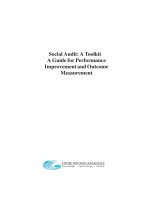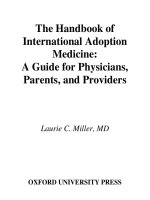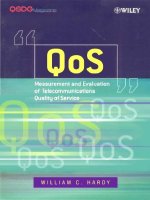John wiley sons s60 smartphone quality assurance a guide for mobile engineers and developers mar 2007 bbl
Bạn đang xem bản rút gọn của tài liệu. Xem và tải ngay bản đầy đủ của tài liệu tại đây (2.22 MB, 220 trang )
S60 SMARTPHONE
QUALITY ASSURANCE
A Guide for Mobile Engineers
and Developers
Saila Laitinen
Nokia, Finland
S60
SMARTPHONE
QUALITY
ASSURANCE
S60 SMARTPHONE
QUALITY ASSURANCE
A Guide for Mobile Engineers
and Developers
Saila Laitinen
Nokia, Finland
Copyright © 2007
John Wiley & Sons Ltd, The Atrium, Southern Gate, Chichester,
West Sussex PO19 8SQ, England
Telephone (+44) 1243 779777
Email (for orders and customer service enquiries):
Visit our Home Page on www.wiley.com
All Rights Reserved. No part of this publication may be reproduced, stored in a retrieval system
or transmitted in any form or by any means, electronic, mechanical, photocopying, recording,
scanning or otherwise, except under the terms of the Copyright, Designs and Patents Act 1988
or under the terms of a licence issued by the Copyright Licensing Agency Ltd, 90 Tottenham
Court Road, London W1T 4LP, UK, without the permission in writing of the Publisher.
Requests to the Publisher should be addressed to the Permissions Department, John Wiley &
Sons Ltd, The Atrium, Southern Gate, Chichester, West Sussex PO19 8SQ, England, or emailed
to , or faxed to (+44) 1243 770620.
Designations used by companies to distinguish their products are often claimed as trademarks.
All brand names and product names used in this book are trade names, service marks, trademarks or registered trademarks of their respective owners. The Publisher is not associated with
any product or vendor mentioned in this book.
This publication is designed to provide accurate and authoritative information in regard to the
subject matter covered. It is sold on the understanding that the Publisher is not engaged in
rendering professional services. If professional advice or other expert assistance is required,
the services of a competent professional should be sought.
Other Wiley Editorial Offices
John Wiley & Sons Inc., 111 River Street, Hoboken, NJ 07030, USA
Jossey-Bass, 989 Market Street, San Francisco, CA 94103–1741, USA
Wiley-VCH Verlag GmbH, Boschstr. 12, D-69469 Weinheim, Germany
John Wiley & Sons Australia Ltd, 42 McDougall Street, Milton, Queensland 4064, Australia
John Wiley & Sons (Asia) Pte Ltd, 2 Clementi Loop #02-01, Jin Xing Distripark, Singapore
129809
John Wiley & Sons Canada Ltd, 6045 Freemont Blvd, Mississauga, ONT, L5R 4J3, Canada
Wiley also publishes its books in a variety of electronic formats. Some content that appears
in print may not be available in electronic books.
Anniversary Logo Design: Richard J. Pacifico
British Library Cataloguing in Publication Data
A catalogue record for this book is available from the British Library
ISBN 978-0-470-05685-1 (PB)
Typeset in 11/13pt Zapf Humanist 601 by SNP Best-set Typesetter Ltd., Hong Kong.
Printed and bound in Great Britain by Antony Rowe Ltd, Chippenham, England.
This book is printed on acid-free paper responsibly manufactured from sustainable forestry
in which at least two trees are planted for each one used for paper production.
Table of Contents
About the Author ........................................................ xiii
Preface ......................................................................... xv
Chapter 1: Introduction to S60 ..................................... 1
1.1 The Competitive Advantage of the S60
Platform .............................................................. 3
1.2 S60 Architecture ................................................. 5
1.2.1 The Symbian Operating System
(Symbian OS) ...................................................... 6
1.2.2 Domestic Operating System (DOS) .................... 6
1.2.3 User Interface (UICon) ........................................ 7
1.3 Summary ............................................................. 7
Chapter 2: Selecting the Baseline ................................. 9
2.1 Manny Lehman’s Law......................................... 10
2.2 What is so Challenging about Selecting
the Best Baseline? .............................................. 11
2.3 How should the Baseline be Selected?.............. 12
2.3.1
2.3.2
2.3.3
2.3.4
Baseline Maturity ..............................................
Customization Maturity ......................................
Least Stable Sub-system .....................................
Program Timing ................................................
13
13
14
14
2.4 Summary ........................................................... 14
vi
S60 Smartphone Quality Assurance: A Guide for Mobile Engineers and Developers
Chapter 3: Release Management ................................ 17
3.1 The Build Cycle .................................................. 19
3.2 Required Testing Activities ................................ 23
3.3 Summary ........................................................... 23
Chapter 4: Binary Compatibility ................................. 25
4.1 API Categorization ............................................. 28
4.2 Maintaining Compatibility ................................. 30
4.2.1
4.2.2
4.2.3
4.2.4
Platform Compatibility .......................................
Platform-based Phone Compatibility .................
Application Compatibility ...................................
Compatibility Dimensions .................................
30
31
32
32
4.3 Binary Compatibility Scenario ........................... 33
4.4 Binary Compatibility Verification ...................... 35
4.4.1 The Binary Compatibility Verification Process .... 35
4.4.2 The Binary Compatibility Verification Suite ......... 36
4.4.2.1
4.4.2.2
4.4.2.3
4.4.2.4
4.4.2.5
4.4.2.6
The SDK Analyser .................................................
The Source Analyser .............................................
The Binary Analyser ..............................................
The Application Launcher .....................................
Binary Compatibility Applications .........................
Third-Party Applications .......................................
36
38
39
39
40
40
4.5 Possible Future Tools ......................................... 40
4.5.1 DepInfo Tool ...................................................... 41
4.5.2 Header Checker Tool ......................................... 41
4.5.3 Ordinal Checker ............................................... 42
4.6 Summary............................................................ 42
Chapter 5: Certificates and Standards ...................... 43
5.1 Technology Certificates ..................................... 44
5.1.1 Java/TCK ........................................................... 44
5.1.2 Bluetooth ........................................................... 47
5.1.2.1 BT Certification Areas ........................................... 47
Table of Contents
5.1.3
5.1.4
5.1.5
5.1.6
5.1.7
Other Technology Licences ...............................
Security Certificates ............................................
Universal Serial Bus ...........................................
Infrared Connectivity .........................................
Multimedia Cards (MMC) ...................................
vii
48
49
50
50
51
5.2 The Open Mobile Alliance (OMA) ................... 52
5.2.1 Process and Principles ........................................ 52
5.3 Cellular Standards and Operators .................... 55
5.3.1 Government and Quality Certificates ................ 56
5.3.1.1 Mandatory ............................................................ 56
5.3.2 Optional ............................................................ 58
5.4 Summary............................................................ 61
Chapter 6: What Quality Means ................................ 63
6.1 Quality Culture .................................................. 64
6.2 Quality Standards ............................................. 66
6.2.1 ISO 9000 .......................................................... 66
6.2.2 Six Sigma ........................................................... 67
6.3 Quality in a Product ......................................... 68
6.3.1 Quality in Manufacturing ................................... 69
6.3.2 Quality in Service .............................................. 70
6.3.3 Getting Better Quality ........................................ 71
6.4 Quality in the S60 Platform and
S60-based Phones ............................................. 73
6.4.1
6.4.2
6.4.3
6.4.4
6.4.5
6.4.6
Choosing the Process ........................................
The Waterfall Process .......................................
The Incremental Process ....................................
Agile Software Development .............................
Concurrent Engineering .....................................
Other Things to Consider ...................................
73
73
74
75
76
77
6.5 Summary ........................................................... 78
viii
S60 Smartphone Quality Assurance: A Guide for Mobile Engineers and Developers
Chapter 7: Stumbling Blocks ..................................... 79
7.1 Stumbling Blocks General to All Projects ....... 79
7.2 Stumbling Blocks Specific to a Software
Program ........................................................... 80
7.2.1 Contradictory, Overwhelming or Too
Many Requirements ............................................
7.2.2 Unstable, Incomplete and Informal
Requirements .....................................................
7.2.3 Poor Planning and Project Management ............
7.2.4 Unrealistic Estimates and Unjustified
Expectations ......................................................
7.2.5 Lack of Knowledge on New
Technologies ....................................................
7.2.6 Lack of Proper Risk Management ......................
7.2.7 Lack of Organisational Integrity..........................
83
83
84
84
84
85
86
7.3 Ways to Avoid Stumbling Blocks in a
Software Program ............................................ 87
7.3.1 Overview of COCOMO .................................... 87
7.4 Stumbling Blocks Specific to a S60-based
Phone Program ................................................ 88
7.4.1 Program-level Risks ............................................. 89
7.4.1.1
7.4.1.2
7.4.1.3
7.4.1.4
7.4.1.5
Integration Competence .......................................
Testing Environment .............................................
Amount of Differentiation ....................................
Baseline Selection ................................................
Defect Fixing Order ...............................................
89
90
90
91
91
7.4.2 Component-level Risks ....................................... 91
7.4.2.1 Coding Style and Culture ..................................... 92
7.4.3 Fixing Speed .................................................... 94
7.4.3.1 Testing Activities and Extent ................................. 94
7.4.3.2 Insufficiency of the Specification ........................... 96
7.4.3.3 Adaptation Layer Implementation ........................ 96
7.5 Provider Components ...................................... 97
7.6 Summary .......................................................... 97
Table of Contents
ix
Chapter 8: Platform Testing versus
Platform-based Phone Testing .................. 99
8.1 The S60 Testing Process .................................. 100
8.1.1 Platform Test Execution Process ........................ 100
8.1.1.1
8.1.1.2
8.1.1.3
8.1.1.4
8.1.1.5
Module/Component Testing .................................
Sub-system Integration Testing .............................
Basic Acceptance Testing (BAT) ............................
Functional Testing ...............................................
System, Localization, Binary Compatibility
and Interoperability Testing .................................
8.1.1.6 Release Testing ...................................................
8.1.1.7 Regression Testing ..............................................
8.1.1.8 Maintenance Testing ...........................................
8.1.1.9 S60-based Phone Testing .....................................
8.1.1.10 Planning based on Baseline Maturity Analysis .....
8.1.1.11 Planning based on Fix Analysis ..........................
102
102
102
103
103
104
104
104
104
107
108
8.2 Summary ......................................................... 108
Chapter 9: Testing as a Tool ..................................... 109
9.1 Testing in Different Processes ......................... 111
9.1.1
9.1.2
9.1.3
9.1.4
Testing in an Iterative Process ...........................
Testing in an Incremental Process .....................
Testing in an Agile Process ...............................
Testing in an Extreme Programming
Process ............................................................
113
114
114
115
9.2 Testing Techniques .......................................... 115
9.3 Testing Phases ................................................. 120
9.3.1
9.3.2
9.3.3
9.3.4
9.3.5
9.3.6
9.3.7
Documentation Testing ...................................
Module Testing ................................................
Integration Testing in the Small .......................
Functional Testing ............................................
Non-functional Testing .....................................
Integration Testing in the Large ........................
The Real User Experience (TRUE) ...................
121
121
124
126
126
127
128
x
S60 Smartphone Quality Assurance: A Guide for Mobile Engineers and Developers
9.4 What then? ...................................................... 131
9.5 Summary.......................................................... 132
Chapter 10: The Testing Environment ...................... 133
10.1 Module Testing .............................................. 134
10.2 Integration Testing in the Small .................... 135
10.3 Functional Testing ......................................... 135
10.3.1
10.3.2
10.3.3
10.3.4
10.3.5
10.3.6
10.3.7
10.3.8
10.3.9
Common ........................................................
UI Customization and Personalization ............
Local Connectivity ........................................
Networking and Data Bearers ........................
Telephony ......................................................
Multimedia ...................................................
Personal Information Management (PIM) ........
Messaging ......................................................
Browsing ........................................................
136
137
138
138
139
140
141
141
143
10.4 Performance Testing ...................................... 144
10.5 Interoperability Testing ................................. 145
10.6 Miscellaneous Testing Activities .................... 146
10.6.1 Certification .................................................. 147
10.6.2 Usability ......................................................... 147
10.7 Summary ........................................................ 148
Chapter 11: Defect Analysis ...................................... 149
11.1 Focused Testing .............................................. 152
11.2 Defect Analysis and Reporting ...................... 153
11.2.1 Defect Database ............................................. 154
11.2.2 The Defect Management Process .................. 154
11.2.3 Defect Priority ................................................ 156
11.2.3.1 Show Stopper ................................................... 156
11.2.3.2 Critical .............................................................. 158
Table of Contents
xi
11.2.3.3 Major ............................................................... 159
11.2.3.4 Minor ............................................................... 159
11.2.4 Defect Reporting ............................................ 160
11.3 Summary ........................................................ 161
Chapter 12: Integration and Build
Environment .......................................... 163
12.1 Software Configuration Management ............ 163
12.2 Changing the Code ........................................ 164
12.2.1 Configuration Management ............................. 166
12.3 Build Environment ......................................... 167
12.3.1 Delivery Structure ........................................... 167
12.3.2 Build Process ................................................. 168
12.3.3 Build Tools ..................................................... 169
12.4 S60 Integration ............................................. 171
12.4.1 Stage 1 ........................................................... 171
12.4.1.1 Step 1: Successful Boot to Textshell ...................
12.4.1.2 Step 2: Simple Application and Launch
via WSER ..........................................................
12.4.1.3 Step 3: Starter Integration and Calculator
Launch .............................................................
12.4.1.4 Step 4: Complete the S60 Boot ........................
12.4.2
12.4.3
12.4.4
12.4.5
Stage
Stage
Stage
Stage
2 ...........................................................
3 ...........................................................
4 ...........................................................
5 ...........................................................
171
172
172
172
172
173
173
173
12.5 Summary ........................................................ 173
Appendix A: Examples of S60 Devices ..................... 175
Appendix B: Glossary ................................................ 179
xii
S60 Smartphone Quality Assurance: A Guide for Mobile Engineers and Developers
Appendix C: References ............................................ 187
Chapter
Chapter
Chapter
Chapter
Chapter
4:
5:
6:
7:
8:
Binary Compatibility ............................
Certificates and Standards ...................
What Quality Means ..........................
Stumbling Blocks ................................
Platform Testing versus
Platform-based Phone Testing .............
Chapter 9: Testing as a Tool .................................
Chapter 11: Defect Analysis .................................
187
187
188
189
189
189
190
Appendix D: Further Reading .................................. 191
Index ......................................................................... 193
About the Author
Saila Laitinen, an engineer, grew up and went to school in Oulu from
where she moved to the capital area of Finland in 1995. She is
married and has two children. She graduated from Oulu University,
from where she gained an M.Sc. in computer engineering.
She joined Nokia in 1995 and has worked in a variety of positions
and organizations within the company since then. She started in
Nokia Networks and worked as a software engineer for three years.
This gave her a solid base including an overall understanding of
software and development challenges as well as network technologies. During those three years she also worked as a project manager
on two software projects. This provided her with first-hand understanding and know-how of how challenging it is to run a project both
to budget and to a given schedule.
After Networks Saila joined the Nokia Ventures Organisation to
lead testing activities in one venture. Then she gained international
experience and worked in Nokia Hungary as an expatriate. In Hungary
her responsibility was to manage the overall testing activities of
Nokia’s very first presence server-product. After Hungary she moved
back to Finland and joined the S60 product line, where she led the
testing, triage and technical consultancy teams. These teams worked
on a daily basis in response to S60 customer products and provided
them with platform expertise in different technologies and activities.
Lastly Saila joined Forum Nokia where she currently leads the global
consultancy function to serve the biggest developer community
innovating on top of Nokia platforms.
Working in all these organizations and both in Finland and abroad
has given her very clear insight into mobile technologies and cultural
differences. Several years experience working with S60 customer
programs has given her the first hand knowledge needed to write
this book.
In addition to this book she has publications in different testing
and quality assurance related conference proceedings.
Preface
The idea of writing this book came to me in 2002. Since then it
slowly matured into a state where I knew exactly what I wanted to
write and finally into an agreement with the publisher John Wiley &
Sons Ltd. S60 is without any doubt the world’s leading smartphone
platform and it is indeed a remarkable one. My dream and target is
to help customers to write programs that create mobile phones on
top of the S60 platform and to help them understand and see the
huge value of it to their businesses. This book explains the S60 platform, platform-based device programs and quality assurance factors
for such programs in sequence, so that the reader gets an understanding of how to prepare and organize the development of a
platform-based mobile device. I have tried to share my experience
and the way I felt while working on S60 so that the reader can discover the fascination of smartphones and also be prepared to handle
the most demanding issues and risks in his project.
The book consists of four parts. The first part starts by comparing
the smartphone concept with the feature phone. The smartphone is
explained naturally through S60 and its architecture. S60 architecture
consists of a cellular modem controlled by modem software, the
Domestic Operating System (DOS), and an application processor
engine controlled by Symbian OS and S60 software. All these parts
are explained to the reader so as to give a comprehensive understanding of the main S60-based device building blocks. In addition I have
explained two of the most important challenges in implementing an
S60-based mobile phone, Binary Compatibility and Certificates.
The second part concentrates on quality, what it means, how to
gain it and what the pitfalls are in gaining the required quality for different product programs. Quality can mean different things to different people. The meaning also varies between products. However, the
one and only common element of quality is the way the consumer or
customer sees the product and how well it fits its use.
The third part explains the most common stumbling blocks in
implementing a high-quality product, with special attention naturally
being given to an S60-based phone program.
xvi
S60 Smartphone Quality Assurance: A Guide for Mobile Engineers and Developers
The fourth part explains the tools used to tackle the challenges
that end with a product with very few errors in the marketplace.
This part starts by introducing testing as a tool to show how far a
program is in its quality targets. Testing alone never increases quality,
it only makes it visible. To understand a product’s quality state makes
it easier to understand how much work is still needed before the
product can be shipped. Increasing quality equals fixing existing
defects. Fixing the right defects is one thing but another one is the
timing of the fixes. Both of these elements are introduced in the
fourth part.
Acknowledgements
Writing this book unaided would not have been possible at all. It is
the result of the very best teamwork one could have. Luckily I have
had a tremendous team to support me every step of the way. This
team not only provided me with lots of material but also generated
new material whenever needed. Even though I might have forgotten
someone, I would still like to highlight the following as part of the
critical chain behind this book: Samuli Paavola, Antti Saukko, Veli
Sertti, Sandor Szilagyi and Mirkka Ylisuvanto. Samuli’s skills and
know-how in error handling enabled me to explain the importance
of proper error management as a success factor in a mobile device
program. Antti brought his invaluable and professional platform and
tools knowledge that helped me with related parts in this book. Veli
gave his expert advice on certification related parts. Sandor provided
his competence beyond comparison to the binary compatibility
related parts of this book. Mirkka helped me understand testing
processes as well as other platform-specific testing-related topics so
that I was able to explain them correctly.
To really understand the issues customers face in their projects
requires first-hand experience. This was given to me by Heidi Melen
and Kalevi Ratschunas. I was honoured to work side by side with
them in one of the Licensee’s device programs. That program opened
my eyes to the challenges that customers have in creating a phone
with S60 on it.
I also feel the need to give my deepest thanks to my employer
Nokia. After being privileged to work for this company for over
eleven years, I appeciate everything this company has given me. It
has given me so much, usually everything I have ever asked for:
Preface
xvii
enough challenges to keep me motivated, enough support and rest
to encourage me when tired and during difficult days plus enough
feedback to become better than I was. I have been fortunate to see
this company from many angles, from the purest R&D work to customer support and strategy work. And I am still humbly looking
forward to all the years to come that hopefully we will share.
Last but not least I need to mention three main supporters of
mine, my husband Hannu, daughter Veera and son Lauri. Hannu has
given me so much inspiration by showing me that one can get results
only by having a hard working mentality. Since this book is a personal
project, I have written it in my spare time. This has unfortunately
meant unforgivable neglect of my most loved ones, Veera and Lauri.
While writing this during weekends, evenings, nights, early morning
hours and holidays, you two asked me whether I would ever have
time for you? I am now happy and relieved to tell you, this project
is finally completed and I am all yours!
Chapter 1: Introduction to S60
It can be surprising to realize how complex a device a mobile phone
really is, and how difficult it is to create one. Because of that, it is not
at all surprising to see how difficult it is for any manufacturer to succeed
in the mobile phone market. The purpose of this chapter is to describe
the tip of the iceberg of why that is so, by describing the elements of a
typical smartphone from a logical architecture point of view. Later
chapters will go into further detail about creating an S60-based device.
The general architecture of an S60-based smartphone consists of a
cellular modem controlled by the modem software, the Domestic
Operating System (DOS) and the application processor engine controlled by the Symbian Operating System (OS) and S60 software.
What is it that makes a device a smartphone? The simplest mobile
phone (Figure 1-1) enables voice calls and short messaging (SMS). In
addition, a contact list can be considered as a fundamental feature
of any mobile device. The next step from ‘any’ device is a feature
phone, which contains some significant additional functionality:
• calendar for keeping track of appointments
• a web or WAP (Wireless Application Protocol) browser
S60 Smartphone Quality Assurance
© 2007 John Wiley & Sons, Ltd
Saila Laitinen
2
S60 Smartphone Quality Assurance: A Guide for Mobile Engineers and Developers
Any mobile phone
-Voice calls
-SMSs
-Contacts
Feature phone
-Voice calls
-SMSs
-Contacts
-MMSs
-WAP
-Camera
-Colour Display
Smartphone
-Voice calls
-SMSs
-Contacts
-MMSs
-WAP
-Camera
-Colour Display
-Access to OS
-Application
background
execution
Figure 1-1. Mobile phone evolution.
• multimedia messaging support (MMS)
• games and other pieces of application software
• a colour display
• a digital camera
• support for additional memory through the use of a memory
card
• etc.
A feature phone has a relatively simple, but effective, proprietary
software environment based on a real-time operating system (RTOS).
Smartphones, on the other hand, use a more advanced, open
high-level operating system with support for multitasking, expandability, multimedia or convergence features, application interaction
and so on.
Feature phone functionality may have support for additional
extensibility through installable software applications, usually based
on the Java 2 Micro Edition (J2ME) technology and the Java programming language from Sun Microsystems. Smartphones, while supporting J2ME, also support software development through direct, native
access to the underlying operating system and its functions (through,
for example, software written using the C+ + programming language).
Perhaps the most notable difference, however, between a smartphone and a feature phone is the way the applications use the phone
resources. In feature phones only one application can be run at any
given time, whereas in a smartphone the execution of multiple
Chapter 1: Introduction to S60
3
applications happens in the foreground (visible to the phone user on
the display) or in the background, and all the applications can access
phone or operating system resources simultaneously, including other
applications and network services.
1.1
The Competitive Advantage of the
S60 Platform
The S60 Platform is the world’s leading smartphone software platform, offering a feature-rich software base for phones with advanced
data capabilities. It includes the Symbian OS and the Nokia S60 UI
(user interface). This UI is the most extensively researched and thoroughly developed graphical user interface (GUI) ever created by
Nokia. Its inclusion in the S60 Platform ensures UI consistency across
all phones based on the S60 Platform from all device manufacturers.
The S60 UI is designed for one-hand operation of advanced and
consumer-friendly data services. It supports a variety of different
functions, including two softkeys, five-way navigation and an application launching and swapping key, as well as Call creation and Call
termination keys. To improve and facilitate text input, it includes a
Clear key and an Edit key. In addition, it uses the standard 12-key
number keypad with alpha printing.
S60 now includes scalable UI support for the following screen
resolutions (in pixels):
• 176 × 208 (classic)
• 240 × 320 (QVGA)
• 352 × 416 (double)
Scalable UI also supports each screen resolution in either portrait or
landscape view and introduces a scalable graphics (SVG) format for
icons and themes.
In addition to the quality assurance of an S60-based phone, this
book guides the reader through the concept, idea and competitive
advantage of S60 in the global smartphone markets. Nokia’s Mobile
Software (MSW) is the organization behind the S60 platform. The
Product Creation Community (PCC) members represent the leading
third-party companies in different regions when it comes to manufacturing a mobile phone. They get the full S60 release at the same
4
S60 Smartphone Quality Assurance: A Guide for Mobile Engineers and Developers
time as the device programs, and are entitled to use it for internal
competence development purposes. There is a Developer Community of developers around the world who are innovating on top of
the Nokia platform. A commonly used description for all these is the
S60 ecosystem. The entire S60 ecosystem is shown in Figure 1-2.
This licensing model enables the platform to be used in different
manufacturers’ device programs.
In addition to the platform itself, MSW works on a reference
hardware that contains the platform as well as modem software.
Developers of customer programs can buy and utilize this preintegrated product as a base for their final product. The usage of the
reference hardware is highly recommended as it provides a halfready product and allows the developer to dedicate resources to
differentiation only.
The term ‘Licensee’ in this book can mean either a Nokia device
program or another manufacturer’s device program. Another name
that is used in this book for the Licensee is customer program.
All customer programs are treated equally. In practice, this means
that all of them have equal access to all platform releases and
documentation.
The Product Creation Community (PCC) is composed of technology integrators and other companies competent to participate in the
customer product program of making a phone. PCC companies can
provide help to Licensees in platform integration, testing and development activities, just to mention a few. S60 Product Creation Community members are divided into four categories:
Licensees
Licensees
Licensees
Licensees
Licensees
PCC
member
Licensees
Licensees
Licensees
Licensees
3rd party
developer
Licensees
Licensees
Licensees
Licensees
3rd party
developer
Licensees
Licensees
Licensees
Licensees
S60 Platform
Figure 1-2. The S60 Ecosystem.









